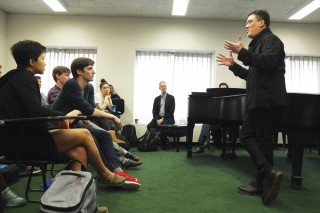Title

Alan Gilbert, the director of conducting and orchestral studies, spoke with the first-year dancers as part of a new classroom exchange program. Brian Zeger (seated by window) is leading a committee on interdisciplinary exchange at Juilliard.
(Photo by Hiroyuki Ito)Conductors and dancers do “similar things from different angles,” Alan Gilbert recently told the first-year dancers. “Conducting is about tempo, of course, but it’s also bringing everything together and conveying the character of the music.” In fact Gilbert (Pre-College ’85; MM ’94, orchestral conducting), who’s the music director of the New York Philharmonic and head of Juilliard’s conducting program, said that he thinks of what he does as dancing—though he quickly added that he’s a terrible dancer.
Body
The occasion was a Music Studies class, a requirement for all 24 first-year dancers, which they take twice a week, all year long. After an informal half hour with the maestro, the dancers spent a half hour in the orchestra rehearsal room, watching some of the conducting students work with the Lab Orchestra to prepare Haydn’s “Surprise” Symphony.
The back-and-forth with Gilbert and the chance to see him work with student conductors was eye-opening, first-year Katerina Eng said afterward. “It was really relatable—he has to lead an entire orchestra with his external and internal physicality.” Gilbert and second-year conducting student Jonathan Spandorf spent a lot of time just on the downbeat of the third movement. “Seeing how a gesture could make the orchestra sound so totally different was fascinating,” she added. And so was seeing that it’s not just dancers who are frequently given adjustments by their teachers—“that happens to us all the time.”
The class was one of the early manifestations of a schoolwide move toward promoting more interdisciplinary exchange at Juilliard. “One way to start that process is to have actors, dancers, and musicians learn about each other’s fields,” said Brian Zeger (M.M. ’82, piano), the artistic director of the Marcus Institute for Vocal Arts, who’s also spearheading a committee to foster such exchanges. The group started meeting in December; the plan is to create interdepartmental programming as well as classwork, despite the inevitable scheduling conflicts that stand in the way of this sort of cross-pollination. “There’s so much expertise in the building, but it’s often siloed,” Zeger said. “If you peep out of your silo, you’ll get fresh ideas.”
For Eng, the chance to observe the Lab Orchestra and meet with other musicians throughout the semester has been great. “We see each other in the dorms and talk about our work, but you can’t really understand it unless you see what they’re doing,” she said. “Being a fly on the wall during their work in progress—that’s when you’re learning and becoming more enriched. To be a part of their world for a little while enriches ours.” She added that something Gilbert had said to her class really stayed with her. “We’re all trying to make somebody feel something, just through different mediums.”




